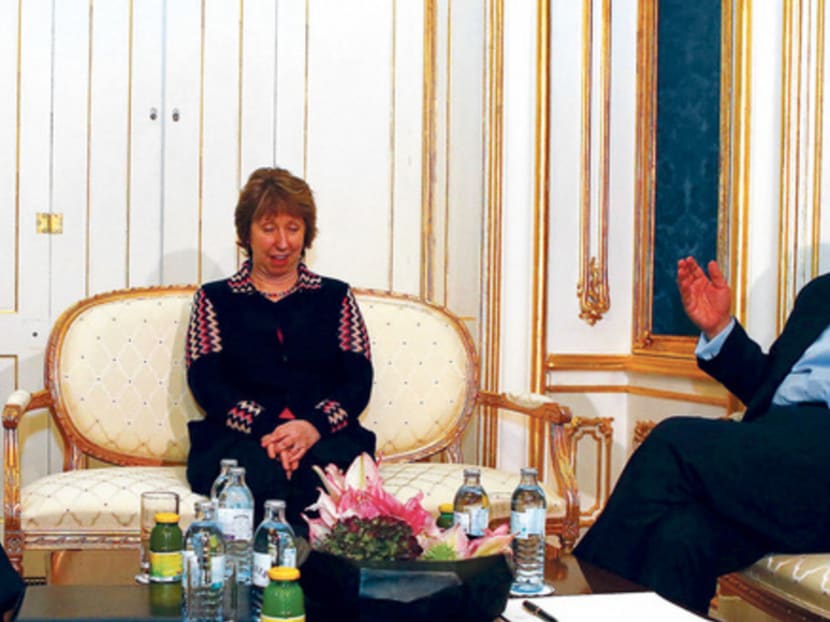US seeks to prevent a covert nuclear weapon in Iran talks
VIENNA — Behind the efforts to close a nuclear deal with Iran lies a delicate question that has been little discussed in public: How to design an agreement to maximise the chances that Western intelligence agencies would catch any effort to develop an atomic bomb at a covert site.

From left: US Secretary of State John Kerry, EU envoy Catherine Ashton and Iranian Foreign Minister Javad Zarif ahead of a meeting in Vienna on Saturday to resolve the stand-off over Tehran’s nuclear ambitions.
Photo: REUTERS
VIENNA — Behind the efforts to close a nuclear deal with Iran lies a delicate question that has been little discussed in public: How to design an agreement to maximise the chances that Western intelligence agencies would catch any effort to develop an atomic bomb at a covert site.
Concern over the possibility of a future Iranian covert programme — and the difficulty of writing a document that deals with the unknown — is rooted in a long history of distrust. But it has been rarely mentioned publicly by negotiators here as United States Secretary of State John Kerry and his European allies press a last-minute effort to resolve more immediate differences. The biggest disagreements centre on how much capacity Iran could retain to make nuclear fuel, and how quickly economic sanctions would be suspended.
Iran itself said yesterday that it will not be possible to meet today’s deadline to reach a comprehensive deal with world powers aimed at resolving the stand-off over Tehran’s nuclear ambitions, the Iranian Students News Agency ISNA reported.
The negotiating efforts focus on the fate of Iran’s three major “declared” nuclear facilities and on lengthening the “breakout” time for Iran to produce enough fuel for a single bomb. But those declared facilities are crawling with inspectors and cameras.
Unstated is the fear of a more problematic issue, referred to as “sneakout”. That describes the risk of a bomb being produced at an undetected facility deep in the Iranian mountains, or built from fuel and components obtained from one of the few trading partners happy to do business with Tehran, like North Korea.
To try to make sneakout more difficult and risky, scientists from the US Department of Energy national laboratories, along with intelligence officers who can be seen hurrying this weekend through lobbies of Vienna’s grand hotels, have been providing ideas to negotiators and scouring the drafts of proposed language in the agreement. The goal is to “make as airtight as possible” the language that would allow highly intrusive inspections to track the precursors and parts that feed Iran’s uranium complex, according to one participant in the negotiations.
The American officials are highly attuned to the findings of a once-classified 2007 National Intelligence Estimate that concluded that Iran ended its head-long race for a bomb in late 2003. But it also concluded that smaller-scale activity continued and warned that “Iran probably would use covert facilities — rather than its declared nuclear sites — for the production of highly enriched uranium for a weapon”.
The threat from covert activities was driven home in the first intelligence briefings given the incoming Obama administration in late 2008 and early 2009, when President Barack Obama and his aides learned that Iran was constructing a hidden centrifuge facility in a mountain outside the holy city of Qum that was so deep it could withstand all but America’s largest bunker-busting bomb. Mr Obama revealed the existence of that facility, called Fordo, in late 2009.
American spy satellites and drones continue to search for hidden tunnel entrances and intelligence officials and private experts say hundreds, perhaps thousands, of underground bunkers and large tunnels now honeycomb the nation.
That is a worry for the future.
“From the beginning, the administration thought a nuclear agreement with Iran would need elements to deal with the overt programme and one to detect covert facilities,” said Mr Gary Samore, Mr Obama’s nuclear adviser during the President’s first term.
American negotiators want an agreement that gives inspectors the right to roam the nation widely and officials say, there needs to be intense monitoring of the manufacturing and shipment of centrifuges — including a highly efficient new generation — so that the atomic energy agency could account for the location of every one.
American officials are also monitoring the activities of the long list of Iranian scientists — many of them under sanctions issued by the United Nations Security Council and the US — who are believed to have been associated with Iran’s programme to develop nuclear arms.
So far Iran has not allowed those scientists to be interviewed, arguing that to reveal their identities and locations would be to invite their deaths. Several have been killed already, often by “sticky bombs” placed on their cars on the way to work.
Iran denies it has ever engaged in weapons activities, saying the evidence cited by the US and used as a source of detailed questions by the IAEA are fabrications.
It is unclear whether American officials will press Iran to publicly reveal any military dimensions of this program. They repeat the mantra that these negotiations “are about the future, not the past”. But the past lurks over the sneakout problem.
“We need to guard against the hidden programme,” said Mr Charles Ferguson, president of the Federation of American Scientists and a longtime advocate of tougher sleuthing. “That’s the most likely route to a bomb. That’s the scenario I worry about the most.”





